Well, I had planned for this article to be a short foray into Standard, but today a ton of Return to Ravnica cards were spoiled. It’s unfortunate when someone just gets a case of cards and spoils the whole slow reveal, but it does give people something to talk about [Editor's note: Feel free to check out the list of illicitly spoiled cards elsewhere on the Internet. MTGO Academy will only post cards visually spoiled with Wizards' permission in its spoiler page, but discussion about all spoiled cards is permitted. --PlanetWalls]. Since I am primarily excited about the upcoming Block format, I figured I’d give some speculating a shot. As of writing this article, 263 of the 274 cards in the set have been spoiled (including basic lands), so we’re about 11 cards short of the full set. These cards could be huge and game changing, so I might have to adapt some of this information as the full set becomes revealed.
The Fixing
Okay, so, the first thing we have to look for in Block Constructed is what kind of colors we are allowed to play. For Scars of Mirrodin, you could play a mono-colored deck, a two-color deck with okay but not great fixing, and if you tried to play more colors than that . . . . In Innistrad Block Constructed, the fixing was all enemy-colored lands, so most decks just picked an enemy pair (red and white) and left it at that or splashed a third color with green’s fixing options (Borderland Ranger, Abundant Growth).
Let’s look at Return to Ravnica‘s options:
- cycle of Duals
- gates, a cycle of fetchable Coastal Towers
- cycle of Keystones
- Transguild Promenade (yuck)
- quite a few hybrid cards (I’m counting these as fixing because they let you play the card in multiple decks)
- Chromatic Lantern
That is a *ton* of fixing options. The median number of colors in the average Ravnican deck will likely be three – for control decks, I would expect five. There are a few reasons for this:
Reason #1: Gold cards are by far the most powerful cards in the set. This is to be expected from a gold set, but I was still surprised while I was looking over the set at just how weak a lot of the mono-colored cards are. A lot of them are just downright awful, and I don’t want to play them in constructed decks. The opposite, however, can be said for the gold cards. Abrupt Decay, Detention Sphere, Dreadbore, Izzet Charm, Lotleth Troll… the list goes on with how many absurd gold cards Wizards of the Coast managed to fit inside this set. Aggressive decks will want to be three colors to ensure they can play their Loxodon Smiters and their Lotleth Trolls in the same deck. With Shocklands and Gates, this is pretty viable, and with just one set in Block right now and nearly all the mono-colored cards being pretty bad, I can’t imagine a two-colored aggro deck emerging – you just give up too much power for not that much more consistency.
Reason #2: Chromatic Lantern is bonkers, and I wish it hadn’t been printed. Don’t get me wrong, I love the card. It’s just kind of annoying how after Shadowmoor Standard (i.e., 5-Color Control Standard), WotC states that manafixing was way too free in that format and that they would tone it down in the future. Then they print this card, which is colorless, an accelerant, and completely fixes all of your mana problems. It can, of course, be blown up with Sundering Growth and others to set back the control player, but it provides such good fixing on top of all the other good fixing in the set (all nonbasic control decks with 4 Lanterns), it’s more of a hope to get them than a sure thing. I can imagine three-color control decks easily, but isn’t it just better to play all five? Where’s the punishment for doing so between Lantern and Mana Bloom?
Reason #3: I really like Mana Bloom. I don’t know if this card is good or not, but it seems pretty good to me. You won’t play it in your aggressive decks, but in a control deck, it’s both a source of ramp (gives you something to do on Turn 2 other than removal spell) and fixing. Granted, drawing multiples is not ideal, and you have to invest time in casting it after it bounces, but this is definitely a card I want to play around with a bit.
Guilds
I’m not really discussing the guilds because they won’t be super relevant in Block Constructed individually: You’ll see a bunch of ‘guild pairs’, which are basically determined by how many duals you can play in a deck. So, right now, we would have:
Grixis: Rakdos + Izzet
This color combination initially sprang to mind as the ‘control trio’, but Rakdos doesn’t actually lend that much to a control deck outside of a few removal spells. Grixis-based control will probably be a lot more viable once Dimir comes out in Gatecrash, but for now it’s mostly on the backburner to five-color. Similarly, Izzet doesn’t add very much aggro to Rakdos’s aggressive strategy, so a Grixis aggro deck is likely not to be better than the green-based options.
“Overgrown Estate/Junk”: Selesnya + Golgari
I don’t see this color combination being anywhere near fast, and I’m not sure how to build it. Selesnya likes to be very slow and grindy with its populate mechanic and giant creatures, which doesn’t mesh well with a lot of the lower-curve Golgari creatures. While Golgari can be slow – Scavenge is very expensive to utilize, and the guild does have some fat – a lot of Golgari’s strength comes from Lotleth Troll being very big and hard to kill, along with a great suite of removal and low-cost creatures. I think the majority of Junk decks will be grindy and slow, using the monogreen accelerants (Axebane Guardian, Gatecreeper Vine) to start pumping out tokens with cards like Korozda Guildmage and Security Blockade. Vraska will definitely make an appearance in this deck, where the main plan will basically be to stall your opponent out with tokens until you can muster enough forces to overwhelm them.
Bant: Selesnya + Azorius
With Detain, this will definitely be the aggressive Selesnya deck. Less focused on tokens and more on putting out high-power, low-cost threats (Brushstrider, Call of the Conclave, Loxodon Smiter) and attacking with them through the opponent’s defenses with the help of detain cards like Lykev Skyknight and Soulsworn Spirit. The Bant deck’s goal as I’m imagining it is to just try to interact as little as possible with your opponent’s blockers, but also to have creatures so large that you’re likely bigger than opponent’s creatures so you can hold back on your detain cards until you need them.
“Lightning Angel“: Azorius + Izzet
Optimal control colors that work well together, so I can see these three colors being the basis for the five-color control decks, along with Grixis.
Jund: Rakdos + Golgari
My bet for the best deck at the start of the format. Rakdos has no shortage of aggressive early-game cards, and Golgari can help in that department but also provides a pretty good late game with scavenge and other fat, upper-end creatures. Rakdos Cackler into Lotleth Troll into Hellhole Flayer into Rakdos, Lord of Riots himself is a very large and fast army, which you can back up with various removal spells and Rakdoss Return.
Other color combinations are possible, obviously, but less reliable due to the lack of Gates and Shocks in their colors.
The Good Cards
There’s really no reason to play colors just because you like them. There have to be good cards in the set that are clearly better than the others. Here’s what I think the better cards in the format are, discounting planeswalkers.
Mizzium Mortars: Enough has been said about this card already for Standard implications, and it’s basically the same in Block. It’s a pretty efficient removal spell on the front end, and it gets backbreaking when you can overload it. As a mono-colored card, however, it doesn’t give a huge draw to a specific color combination, and because its overload cost is so red-intensive, it can be hard to overload at times. Still a worthy inclusion, though not as good as you might think at first.
Dreadbore: For the longest time, the best bet in Block has always been to play the color combination with the best planeswalkers. WotC has apparently gotten wise to this, as they put both planeswalkers in this set on unfriendly terms (there is no GBU “Fungal Shambler” crossover dual in this set), and also printed Dreadbore, a 2-mana way to completely undo that planeswalker you were inching up to ultimate. This card is a prime reason to play RB, along with all the other aggressive creatures in the color.
Lotleth Troll: I’ve mentioned this card a lot in this article so far, because I think it is very good. It gets very big, interacts wonderfully with Scavenge, and is basically unkillable; only Stab Wound and Auger Spree are reliable answers to it. Meanwhile, this unkillable thing is trampling all over anything that gets in its way.
Rakdos, Lord of Riots: This card looks completely bonkers to me – 4 mana for a 6/6 flying trampler, and the only condition is that I have to hit them? That seems relatively easy to accomplish in a deck playing red and black. It also makes your creature spells a little easier to cast, but that’s probably not relevant since your 6/6 flier is killing them too fast for you to put out too many more creatures.
Rakdoss Return: A large endgame finisher and disruption midgame for the various RB decks out there. It reminds me of Blightning, but a lot less crippling in the early game, and significantly more devastating in the late.
Supreme Verdict: I don’t know if this card will be successful, but it will definitely find a way into all of the control decks that can cast it. It kills everything short of Lotleth Troll (which is also on this list), and that’s not to be just scoffed at.
Chromatic Lantern: Colors? What sort of limitation is that?
The Planeswalkers
Ironically, for this set, this card is probably harder to cast than Vraska due to his double blue cost, though it’s likely not an issue for a 4-drop planeswalker suited for a Chromatic Lantern deck. I’ve heard differing accounts on Jace, anywhere from “he’s terrible, the worst planeswalker since Tibalt” to “buy 4 while you can for cheap”. I’m generally in the latter camp; I think Jace is better than he appears. His +1 is very underwhelming when you read it, but remember that his abilities just don’t exist in isolation. You should have some sort of board state, or a deck capable of achieving a board state, to let Jace shine. For the Mind Sculptor, this was any board state known to man, and has spoiled the name ‘Jace’ for many. Jace, Architect of Thought excels in board stalls. If you’re in one, he draws you cards to your win condition in chunks of three (yes, you only get one card generally, but free mini-Impulses are still good). If you aren’t in a board stall where you can protect Jace, you make your opponent’s forces drastically worse and just generally make combat more difficult for your opponent. I’m not certain he’ll be a big hit in the format, but I do know that if Dreadbore weren’t in the format, he would without question be a top card. He still might be.
I was initially put off by this planeswalker. I didn’t like how if you used her uptick ability (the +1 No Mercy), your opponent was immediately put off from pressuring Vraska anyway, so she just didn’t do anything when she hit the board. I eventually figured out that you want to hit a board state where you can play Vraska, immediately nuke a permanent, and then your opponent can’t retaliate due to lack of creatures. Then you uptick her and defend while she does the rest of the work. However, with all of the Golgari cards tending toward the aggressive side (paired with Rakdos), she’ll likely only see play initially as a sideboard card, or just in the various 5-color decks. I’m unsure where this planeswalker fits in the grand scheme of things, but I know that she is good and I look forward to playing her.
Okay, so this article was very long for just a brief little overview of what I think Return to Ravnica Block might be like. Next time I’ll likely blind you guys with some science, throwing some decklists together when the remaining 11 cards or so are spoiled and I have a little more time to tinker with things. However, I hoped you enjoyed this article and thank you for reading.
Please comment if you have any questions or want to call me out on something!
Lee McLeod
@leemcleo on Twitter
Gard on MTGO

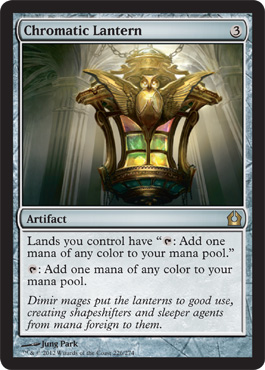
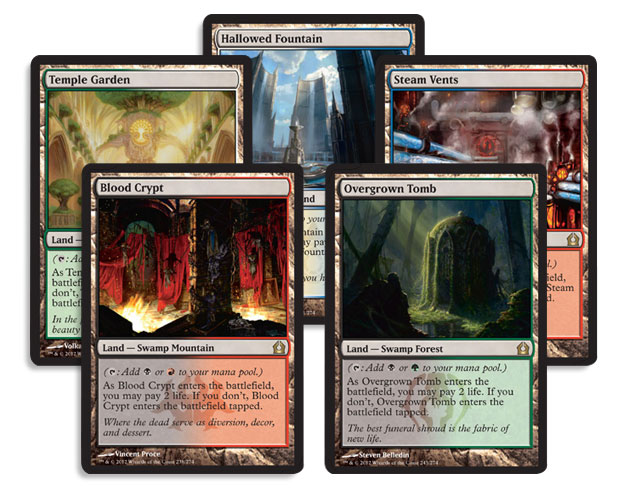
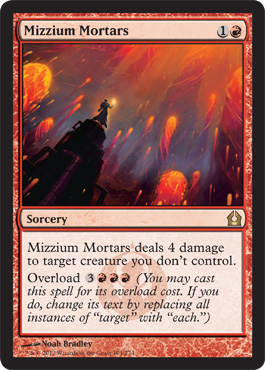
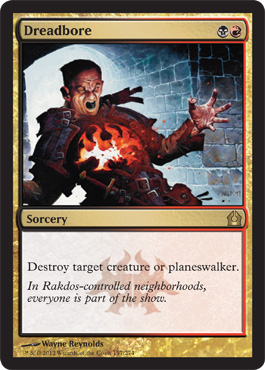
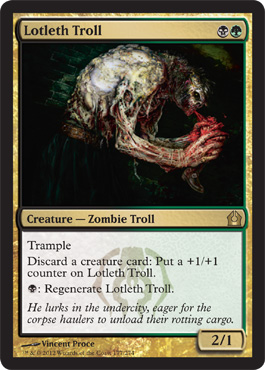
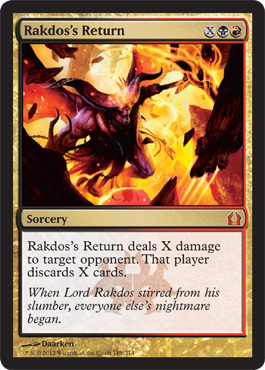
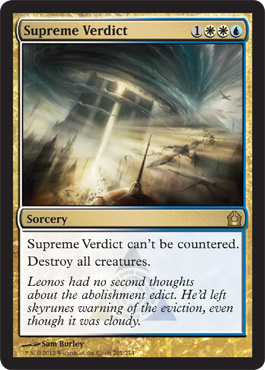
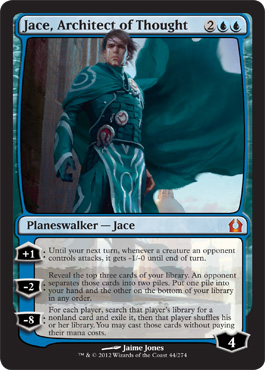
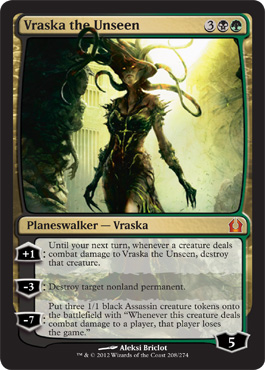
Hey, Lee, I like your vids, and your articles are not half bad either… Im looking forward to see how block for RTR pans out, and too your new videos as well
Its going to be exciting to see this block unfold since I missed the original Ravnica. I really loved watching you go trhough Innistrad. This time around I hope to actually play. What approach are you taking as far as acquiring cards? Buy everything early regardless of price to start playing any deck, or try to let some of the speculative cards settle a bit? Since single set block is usually hailed as a great way to break into constructed online, do you play a ton of release events also?